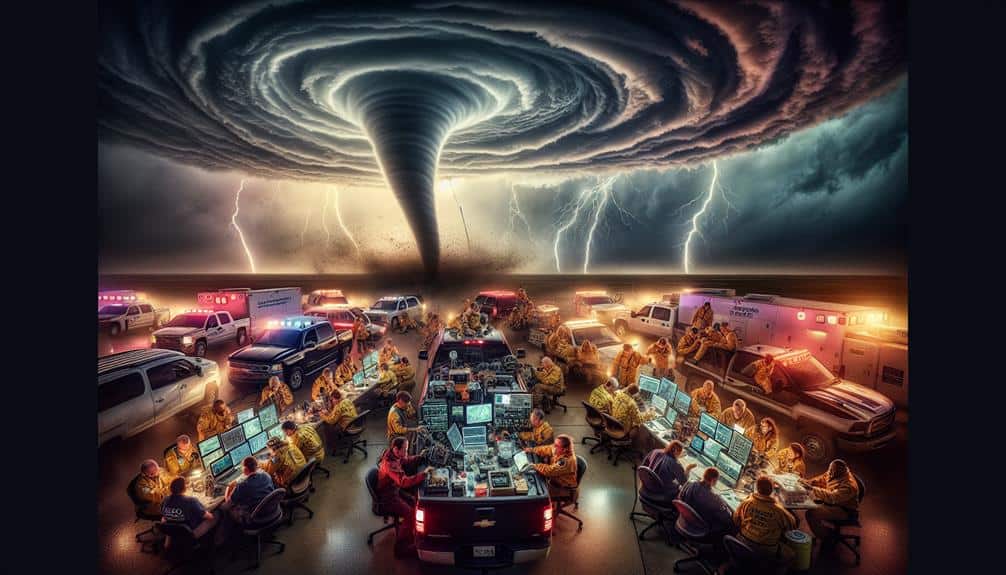We can't overlook that climate change is significantly impacting how we coordinate emergency response efforts. With the frequency of severe storms more than doubling in the past two decades, our strategies must evolve. We need resilient communication systems to guarantee seamless coordination. Real-time data integration, AI, and interoperable platforms are key for efficient resource allocation. Training and cross-agency collaboration enhance preparedness, while community engagement strengthens resilience. By adopting these strategic measures, we can enhance our response capabilities and adapt to the challenges posed by climate change. Let's explore the steps necessary to fortify our emergency response systems.
Key Points
- Increasing storm frequency stresses emergency response coordination and requires agile, well-resourced units.
- Communication infrastructure resilience is crucial for maintaining coordination during climate-induced disasters.
- Real-time data integration enhances situational awareness and resource allocation during emergencies.
- Cross-agency collaboration improves response strategies and information sharing for effective crisis management.
Increasing Frequency of Storms
The increasing frequency of storms, driven by climate change, greatly stresses emergency response coordination. As storms become more frequent and severe, our emergency response systems face unprecedented challenges. We need to address these through thorough storm preparedness strategies.
Research indicates that the number of storms classified as severe has doubled over the past two decades. This escalation demands that our emergency response units remain agile and well-resourced.
Our storm preparedness plans must include pre-positioning essential supplies, ensuring ready access to evacuation routes, and maintaining clear communication channels. We can't afford to be reactive; we need to be proactive.
By analyzing past storm responses, we can identify weaknesses and implement strategic improvements. For instance, investing in advanced weather prediction technology and training programs for first responders can significantly enhance our readiness.
Furthermore, community engagement is essential. Educating the public about storm preparedness and involving them in drills can build resilience at the grassroots level. We've to recognize that freedom comes with responsibility—being prepared isn't just a governmental duty; it's a communal one.
Impact on Communication Systems
Effective communication systems are pivotal in coordinating emergency responses during climate-induced storms. We've seen that network resilience is vital for maintaining communication amidst disruptions. Without robust, resilient networks, our ability to respond promptly and effectively is significantly compromised.
For instance, during Hurricane Maria, Puerto Rico's communication infrastructure crumbled, severely hampering relief efforts. This underscores the need for investing in resilient, redundant communication networks that can withstand the increasing severity of climate events.
Moreover, data integration plays a strategic role in enhancing our communication systems. When multiple agencies and responders can seamlessly share real-time data, it allows for more coordinated and efficient responses.
Imagine a scenario where satellite data, weather forecasts, and on-ground reports are integrated into a unified platform. This would enable us to make informed decisions swiftly, ensuring resources are deployed where they're needed most.
We must also consider emerging technologies like 5G and IoT, which offer greater data integration and network resilience. By leveraging these advancements, we can create a more adaptive and responsive emergency communication framework.
In an era marked by climate uncertainty, our commitment to strengthening communication systems isn't just strategic—it's essential for safeguarding lives and maintaining our freedom.
Resource Allocation Challenges
Managing resource allocation challenges during climate emergencies demands a strategic approach grounded in real-time data and adaptive planning. We must navigate funding constraints and operational logistics to guarantee resources are effectively deployed where they're most needed. Budget limitations often restrict our ability to stockpile supplies and invest in advanced equipment, making it vital to prioritize critical needs and explore alternative funding sources.
Staffing shortages further complicate our response efforts. As climate emergencies increase in frequency and intensity, the demand for trained personnel outpaces supply. We need to develop robust training programs and partnerships with volunteer organizations to bridge this gap. Additionally, deploying staff efficiently requires us to use predictive analytics to anticipate needs and allocate human resources dynamically.
Equipment availability is another significant hurdle. Our current inventories are often insufficient to meet the demands of large-scale disasters. By investing in versatile, multi-use equipment and establishing mutual aid agreements with neighboring regions, we can enhance our capacity to respond.
Technological Adaptations Needed
Leveraging advanced technologies is crucial in overcoming the resource allocation challenges posed by increasingly frequent and severe climate emergencies. We must strategically adopt and integrate cutting-edge tools to enhance our emergency response capabilities. By doing so, we can guarantee a more efficient and effective coordination during crises.
One key aspect is data integration. By consolidating real-time data from various sources, we can gain thorough situational awareness. This enables us to allocate resources more accurately and respond to emergencies faster. For instance, integrating satellite imagery with weather data and social media feeds can provide a multidimensional view of an unfolding disaster.
Moreover, embracing technological advancements such as AI and machine learning can notably improve our predictive capabilities. These technologies can identify patterns and predict potential hazards, allowing us to mitigate risks before they escalate into full-blown emergencies.
To achieve these goals, we should focus on:
- Developing interoperable platforms: Guarantee seamless communication between different agencies and systems.
- Investing in resilient infrastructure: Upgrade existing systems to withstand extreme weather conditions.
Training and Preparedness

We must prioritize simulated disaster scenarios to enhance our emergency response skills, ensuring they reflect the complexities brought on by climate change.
Cross-agency collaboration is critical, as it fosters seamless communication and resource sharing.
Simulated Disaster Scenarios
Simulated disaster scenarios play an essential role in enhancing emergency response coordination by allowing teams to practice and refine their strategies in a controlled environment. As climate change continues to amplify the frequency and severity of natural disasters, our need for effective emergency simulation grows more critical. By engaging in these simulations, we can better understand our disaster response capabilities and identify potential gaps in our preparedness.
We've found that emergency simulations offer several strategic advantages:
- Realistic Training: These simulations provide a safe yet realistic setting to test our response strategies, ensuring that our teams are ready for actual emergencies.
- Performance Metrics: By analyzing the outcomes of these drills, we can derive valuable performance metrics that highlight strengths and pinpoint areas needing improvement.
The evidence is clear: well-executed emergency simulations enhance our ability to respond effectively and efficiently in real-world situations.
Through these strategic exercises, we can bolster our disaster response efforts, ultimately preserving our autonomy and safeguarding our communities.
Let's continue to prioritize these simulations to remain resilient in the face of climate change's growing challenges.
Cross-Agency Collaboration
Building on the insights gained from simulated disaster scenarios, effective emergency response hinges on robust cross-agency collaboration during training and preparedness phases. It's evident that without smooth data sharing and coordinated response planning, our efforts can fall short, leaving communities vulnerable. By fostering an environment where agencies work together, share critical information, and align their strategies, we enhance our collective capacity to respond swiftly and effectively.
Strategically, it's crucial to prioritize regular joint training exercises. These drills not only refine our response capabilities but also build trust and familiarity among different agencies. When we simulate real-world challenges, we identify gaps and streamline our communication protocols. This guarantees that when a disaster strikes, we're not slowed down by bureaucratic delays or misinformation.
Data sharing plays a pivotal role in this collaboration. By leveraging real-time data analytics, we can make informed decisions swiftly. Agencies must adopt interoperable systems that allow for the seamless exchange of information. This interconnected approach to response planning guarantees that resources are deployed where they're needed most, and actions are coordinated efficiently.
Ultimately, our goal is to create a resilient framework that empowers us to protect and serve our communities effectively in the face of climate-induced emergencies.
Resource Allocation Strategies
Effective resource allocation strategies in training and preparedness are critical to ensuring a swift and coordinated emergency response to climate-induced disasters. We must implement targeted funding strategies to guarantee that resources are available where they're needed most.
By carefully planning equipment distribution, we can make sure that essential tools and supplies are always on hand when a crisis hits.
To develop comprehensive strategies, we need to focus on:
- Funding strategies: It's crucial to secure sustainable funding sources that can be quickly mobilized. This includes public investments, grants, and private partnerships.
- Equipment distribution: Strategic stockpiling and efficient logistics systems should be in place to reduce response times and improve access to critical resources.
Collaboration Among Agencies
To enhance our emergency response capabilities in the face of climate change, we must focus on robust interagency communication strategies, effective resource sharing protocols, and thorough joint training programs.
Evidence shows that coordinated efforts lead to more efficient and timely responses.
Strategically, prioritizing these elements will strengthen our collective resilience and operational efficiency.
Interagency Communication Strategies
Leveraging interoperable communication systems, we can greatly enhance the efficiency of emergency response coordination among various agencies. By establishing robust interagency partnerships and standardized communication protocols, we guarantee that every stakeholder is on the same page, minimizing the risk of miscommunication.
Effective coordination strategies are essential for maximizing response efficiency, especially as climate change exacerbates the frequency and severity of emergencies.
To achieve seamless communication, we should focus on:
- Unified Communication Platforms: Deploying integrated systems that allow different agencies to communicate in real-time, regardless of their individual platforms.
- Standardized Protocols: Establishing and adhering to common communication protocols to facilitate clear and concise information exchange.
These strategies not only streamline the flow of information but also empower agencies to act swiftly and decisively.
As we navigate the future's uncertain climate landscape, a coordinated and efficient response framework will be our strongest asset. By prioritizing interoperable communication, we're not just improving response times; we're safeguarding lives and property, giving communities the resilience they need to thrive.
Resource Sharing Protocols
Building on the foundation of strong interagency communication, we must also establish efficient resource sharing protocols to guarantee all agencies have the tools and support needed during emergencies. Without well-defined coordination protocols, our response efforts can become fragmented, leading to delays and inefficiencies that jeopardize public safety.
By formalizing resource sharing, we assure that every agency, regardless of size or budget, can access critical resources like specialized equipment, personnel, and information systems.
Evidence from recent climate-induced disasters highlights the importance of these protocols. For instance, during wildfires or hurricanes, the swift allocation of resources like firefighting teams, medical supplies, and communication tools impacts the effectiveness of our response. Strategic resource sharing allows us to pool our strengths, mitigating gaps that no single agency could cover alone.
To implement these protocols, we must develop standardized agreements outlining resource allocation, responsibilities, and reimbursement procedures. This strategic approach not only enhances operational efficiency but also fosters a culture of mutual support and trust among agencies.
In an era where climate change continually tests our emergency response capabilities, robust coordination protocols are crucial for guaranteeing we remain resilient and prepared.
Joint Training Programs
Joint training programs are crucial for guaranteeing all agencies can seamlessly collaborate and respond effectively during climate-induced emergencies. When multiple agencies operate together, interagency cooperation becomes the backbone of a successful emergency response. These joint training programs help us bridge gaps between different organizational cultures and operational protocols, enhancing our collective ability to act swiftly and decisively.
To maximize training effectiveness, we need to focus on several key elements:
- Scenario-Based Drills: Conducting realistic scenario-based drills allows agencies to practice responding to potential emergencies in a controlled environment. This not only tests our readiness but also highlights areas needing improvement.
- Communication Protocols: Establishing clear communication protocols guarantees that information flows smoothly between agencies. This is critical in fast-paced situations where miscommunication can lead to delays or errors.
Community Engagement Strategies

Effective community engagement strategies are essential for enhancing the resilience of local populations in the face of climate-induced emergencies. Acknowledging that increasing public awareness is the cornerstone of a robust response framework.
By educating our communities about potential climate threats and appropriate responses, we empower individuals to act decisively and independently when emergencies arise.
Furthermore, stakeholder engagement can't be overlooked. It's crucial to bring together local governments, businesses, non-profits, and residents to form cohesive action plans. When everyone understands their role and contributions, coordination becomes more seamless, and the community stands stronger.
Strategically, it's important to leverage existing community networks and digital platforms to disseminate critical information quickly. Social media, local news, and community bulletin boards serve as effective tools for real-time updates and guidance. Evidence shows that communities that are well-informed and actively engaged are more likely to adopt preventative measures and respond efficiently during crises.
Lastly, let's prioritize inclusive dialogue sessions where community members voice concerns and propose solutions. This participatory approach fosters a sense of ownership and accountability, essential for sustaining long-term resilience.
Together, by adopting these strategies, we can navigate the challenges posed by climate change more effectively.
Frequently Asked Questions
How Does Climate Change Affect Mental Health in Emergency Response Teams?
Climate change increases stress in emergency response teams, challenging team resilience. We need effective stress management, psychological support, and coping strategies to maintain mental health and ensure we're prepared for anything. Evidence shows these strategies are crucial.
What Role Do International Organizations Play in Climate-Related Emergency Responses?
We believe international organizations play a critical role by fostering global partnerships and collaboration. They strategically allocate resources and manage logistics, ensuring efficient climate-related emergency responses. This coordinated effort enhances our collective resilience and freedom.
How Are Insurance Companies Adapting to Increased Climate-Related Emergencies?
Just like Odysseus steering through turbulent seas, we see the insurance industry embracing climate adaptation strategies. They're revising risk assessments, updating policies, and investing in predictive technologies to stay ahead of increasing climate-related emergencies.
What Are the Economic Impacts of Climate Change on Emergency Response Budgets?
We're seeing significant financial strain on emergency response budgets due to climate change. Resource allocation becomes more challenging as funds must cover increasingly frequent and severe disasters, impacting our ability to maintain efficient and effective response strategies.
How Does Urban Planning Incorporate Climate Change to Enhance Emergency Response?
We juxtapose resilient infrastructure and disaster preparedness to guarantee our cities withstand climate impacts. By strategically integrating these elements into urban planning, we enhance emergency response and empower communities to face future challenges with greater freedom and security.


